Why did Amazon bet billions on ‘Patagonia’ pickups? Rivian’s RJ Scaringe
Oct. 5, 2025 at 6:00 am Updated Oct. 5, 2025 at 6:00 am
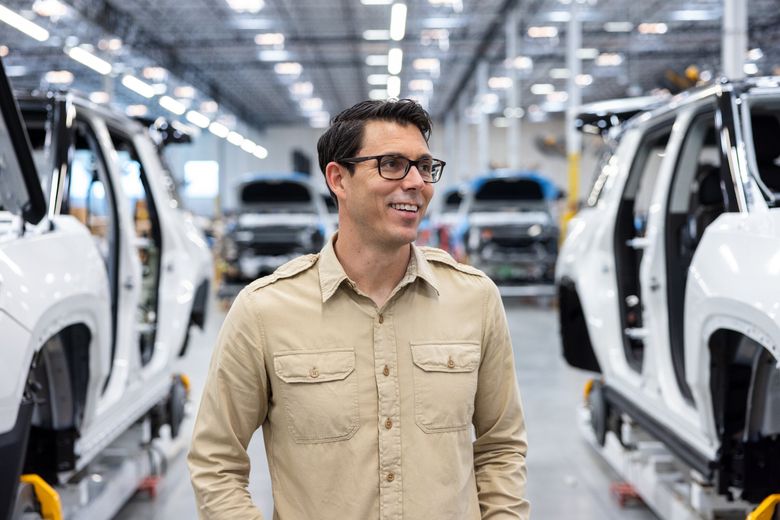
RJ Scaringe, CEO and founder of Rivian Automotive, on the pilot production line at the company’s plant in Irvine, Calif., in 2023. (Alisha Jucevic / Bloomberg)
By
Christina Kunkel
Special to The Seattle Times
Rivian CEO Robert Joseph Scaringe does not seem like someone easily overwhelmed by circumstance.
It is just after 8 a.m. in Palo Alto, Calif., and Scaringe has already hit the gym. Scaringe wears simple gray cargo pants and a matching T-shirt seated in a modest room in the former elementary school repurposed as Rivian’s Silicon Valley headquarters. A protein drink, a glass of water and a coffee have been set out for him.
At 42, Scaringe — “RJ” to colleagues — has been praised as an auto industry innovator and criticized as a untested entrepreneur in over his head.
He founded Rivian at age 26, launching an electric vehicle company that may yet challenge Tesla. Rivian’s expensive vehicles, available exclusively in the United States, evoke an ethos of environmental consciousness and outdoor life that appeals to Northwest sensibilities. Scaringe, himself a vegan and outdoor enthusiast, describes Rivian as “Patagonia for pickups.”
Scaringe’s initial investor was the owner of a small-time Porsche restoration shop where he worked as a teenager, who put up several hundred thousand dollars. Scaringe took years to gain traction among investors.
“I had no money, no technology, no brand, no plant, no suppliers, and only one employee — myself. The odds of success were one in a billion,” he recalled.
As Rivian grew, though, it attracted large corporate investors, including Amazon and Ford, whose combined support ultimately totaled $14 billion. The company rebuilt a Mitsubishi facility in Illinois, then went public near the end of 2021.
Initially valued at $129.95 per share, Rivian’s valuation collapsed 89% in the months after its IPO but has held relatively steady since late 2022 and was trading at between $17.14 and $9.50 a share this year.
The American automotive sector’s future, it seemed when Rivian launched, would be characterized by electrification.
For the first time, the United States saw an alternative to Tesla producing desirable, environmentally friendly vehicles. Scaringe emerged as a significant figure within an industry that faces greater challenges domestically than abroad, due in part to the American affinity for powerful pickups.
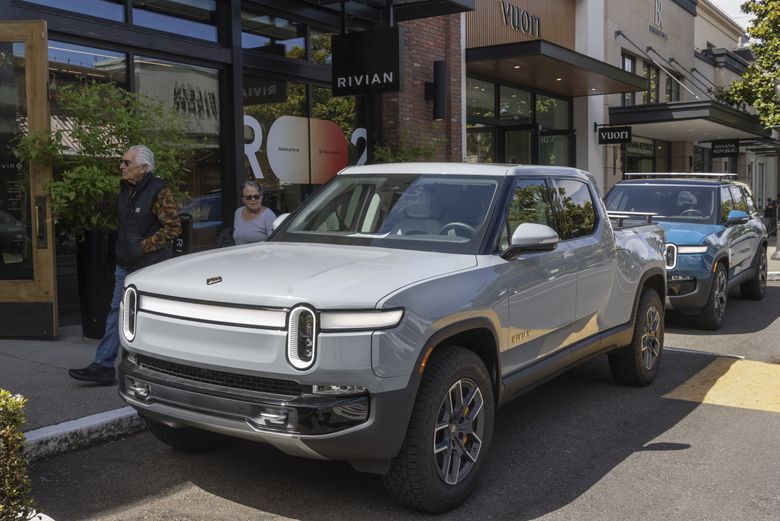
Rivian displays two EVs hitting the market in 2026 inside its space at University Village in Seattle. (Ellen M. Banner / The Seattle Times, 2024)
Now, that prospect faces new questions. Scaringe is contending with a White House hostile to electric vehicle subsidies and a president with a close, if turbulent, relationship to the founder of his chief competitor. Already, Trump has rescinded the $7,500 federal tax credit for electric vehicle buyers, which disappeared at the end of September, while rolling back regulations intended to mandate cleaner vehicle fleets.
The timing has proved challenging for Scaringe.
Rivian, like most early-stage companies, expects to continue to lose money. Its losses are forecast to hit $2 billion for 2025 as it builds manufacturing facilities and expands its supply chain. Since 2021, Rivian’s Illinois plant has produced approximately 140,000 vehicles — including the R1 pickup and R1S SUV — dwarfed by Tesla’s annual global production of 2 million vehicles.
Global trade disputes have also hit Rivian. Although Rivian manufactures domestically, crucial components — including batteries, glass and wiring — are sourced internationally. Its Illinois plant experienced shortages of rare earth materials used in electric motors, nearly halting production.
China, an early target in Trump’s off-and-on tariff push, is the primary producer of those materials. The trade troubles increased vehicle costs by several thousand dollars.
Rivian has conducted two rounds of layoffs this year, cutting employees to reduce costs. Rivian let go of about 1% of its workforce in June, targeting production staff, and then in September cut 150 workers, mainly from the sales workforce. The automaker currently employs around 14,000 people.
Scaringe says he remains confident in the inevitability of electrification, though he acknowledges the “headwinds” facing his company and industry. He appears undeterred, and optimistic.
Related
on amazon
“Thirty or 40 years from now, we’ll look back and say there was that little speed bump, but it will be clear the world has transitioned to electrification,” he states. “Anything we’re seeing in terms of shifts in the administration’s policy doesn’t change the end state.”
But many manufacturers are now pulling back their investments in electrification. “I think that’s bad for my kids, bad for my kids’ kids, and really bad for the U.S. auto industry,” says Scaringe. But he also hopes that retrenchment creates a less competitive environment for Rivian and Tesla.
Whether Rivian will endure until the sector stabilizes remains uncertain. For years, battery electric vehicles have held a market share of approximately 8% in the U.S., well below the share they enjoy in Europe and China. EV adoption has been most common in wealthier, more progressive regions, like Seattle.
Scaringe’s personal journey illustrates the shift he believes other Americans will make.
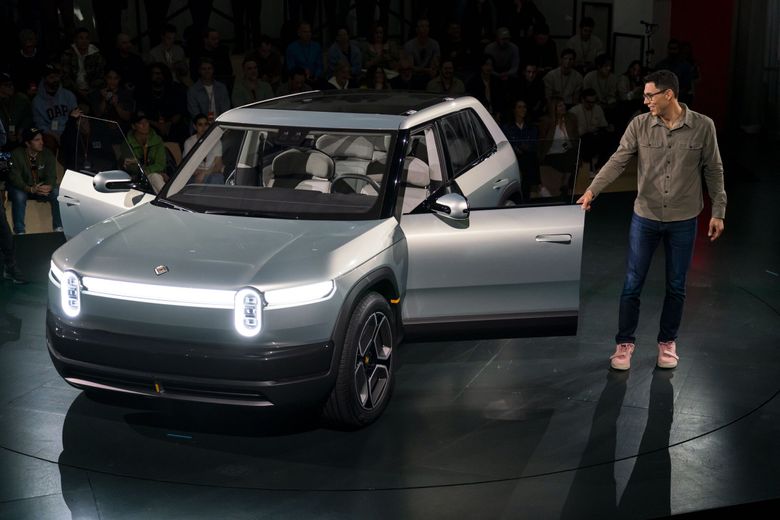
RJ Scaringe, CEO and founder of Rivian Automotive, unveils a Rivian R3 prototype crossover electric vehicle during an event in Laguna Beach, Calif. (Kyle Grillot / Bloomberg, 2024)
As a younger man, he liked vehicles with large, inefficient engines — his first car was a VW Corrado with a six-cylinder engine. Even today, he keeps one in his garage. As a student, Scaringe visited the Porsche factory in Germany, which he regards as a “sacred place.” But that passion for automobiles was in tension with his passion for the environment, a conflict that set him on a path to launching Rivian.
Most Read Business Stories Scaringe is frequently compared with Tesla CEO Elon Musk. While both are often praised for technical competence, Scaringe’s reserved leadership style is distinct from Musk’s.
Former automotive executive Michael Dunne notes that bold strategic vision is sometimes essential for market breakthroughs, and Rivian’s long-term direction is unclear.
“One of the lessons of Tesla is you got to be out there telling your story every single day. Sometimes in crazy and unexpected ways,” Dunne said. “Elon Musk promises things and he doesn’t get there till later maybe. But people get excited about that. He’s got a vision. I still don’t know what’s the vision for Rivian.“
Dunne describes Scaringe as “understated, humble and smart.” Acting like Elon Musk “might not be his comfort zone.”
Comparisons of market capitalization — Tesla’s approaching $1 trillion versus Rivian’s $16 billion — indicate investor preference for Musk’s approach.
But Scaringe imitates best practices from industry leaders, as demonstrated at the new Rivian “Space” showroom in Palo Alto, which eschews the term “dealership” and designates staff as “advisers.” Customers receive boutique experience, branded merchandise and test-drives of vehicles priced from $78,000.
In Washington, as in some other states, Rivian is still prohibited from selling cars directly to consumers due to laws banning direct sales by electric-vehicle-only manufacturers. Although Rivian operates a showroom in Seattle, customers are not allowed to purchase vehicles there.
While Tesla benefits from a legal loophole permitting direct sales, Rivian and other brands must rely on complex workarounds, such as having customers complete purchases through other states and then shipping vehicles to Washington or ordering their cars online.
Despite these restrictions, Scaringe asserts Rivian has “the best-selling premium SUV over $70,000 in the state of Washington,” which comes as a surprise given the sales hurdles faced by the company in the state.
Technical innovations hide beneath Rivian’s minimalistic interiors, such as reducing the number of computers from the industry-standard 130 to only three, which decreases complexity and minimizes supplier dependency. Rivian is attempting to shorten development cycles and cut costs, breaking practices that have left established industry players like the Detroit auto giants struggling launch EVs that compete with Tesla.
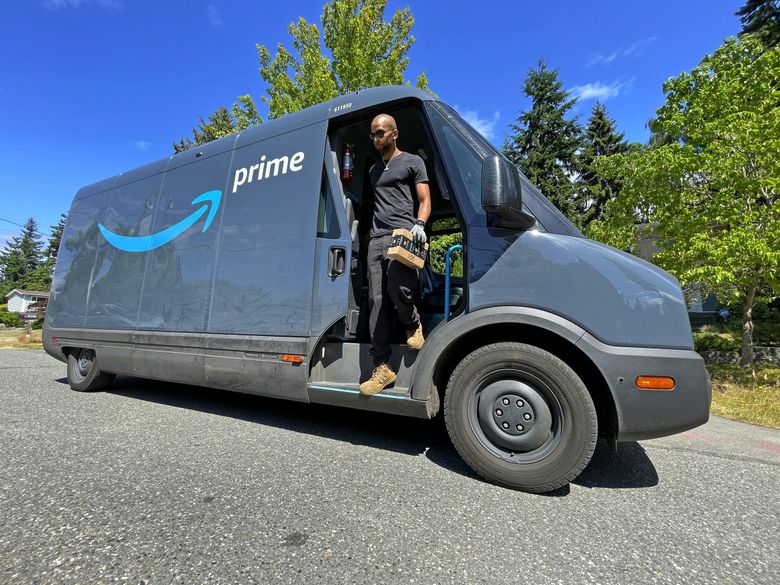
An Amazon delivery is made using a Rivian electric vehicle in Edmonds in July 2023. (Ken Lambert / The Seattle Times, 2023)
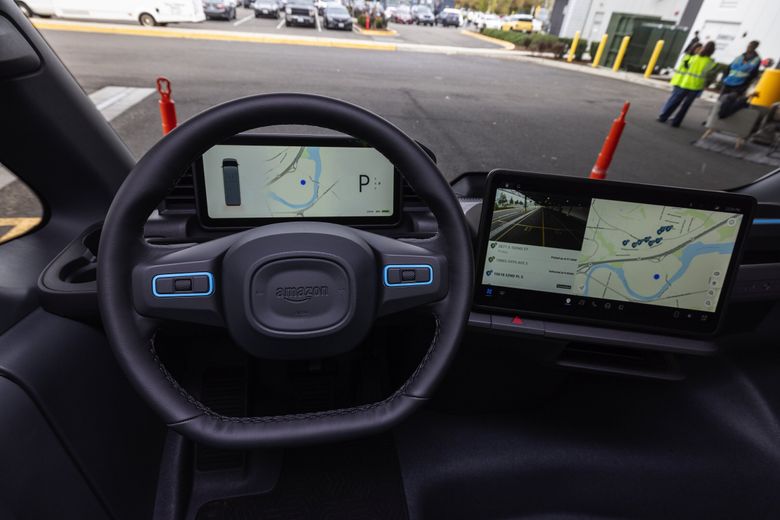
A heated steering wheel, rear camera view and dashboard maps are seen during an Amazon press event to show off its Rivian electric delivery vans in October 2023 in Tukwila. (Ken Lambert / The Seattle Times, 2023)
Amazon is still the largest investor in Rivian, holding around 13.3% of the shares. By 2030, Rivian is expected to provide 100,000 electric delivery vans to Amazon. The partnership is intended to help the tech giant reach net-zero carbon emissions by 2040.
By mid-2025, 30,000 of these vehicles had been delivered. The deal originally specified Rivian would build the vans exclusively for Amazon, but in 2023 the automaker announced it would offer the vehicles to other companies.
Collaboration with VW, initiated after a meeting between Scaringe and Volkswagen Group CEO Oliver Blume, resulted in an extraordinary joint venture. In 2024, Volkswagen pledged an investment of nearly $6 billion to support joint software development efforts, with engineers from both companies working in California. The companies hope to put Rivian technology into a VW model by 2027.
Scaringe now faces a critical juncture. In a facility adjacent to his office, the prototype for the R2 — a smaller, less expensive SUV intended for release in 2026 — awaits further development. The model will represent Rivian’s first foray into the mass market, targeting a price point of $45,000 and designed for both U.S. and European consumers.
Ultimately, Scaringe believes mass EV adoption is inescapable: “We don’t have a fallback. We can’t go back to making V8 trucks, so we have to make it work with electrification.“
Christina Kunkel spent two months with The Seattle Times through the Arthur F. Burns Fellowship for journalists, visiting from Munich’s Süddeutsche Zeitung. Kunkel conducted the interview for this story, which was written with the assistance of an AI-powered translator, then edited line by line for style and sense by human journalists. Feel free to contact Levi Pulkkinen, Seattle Times business editor, at lpulkkinen@seattletimes.com with questions.
Christina Kunkel.
seattletimes.com |









